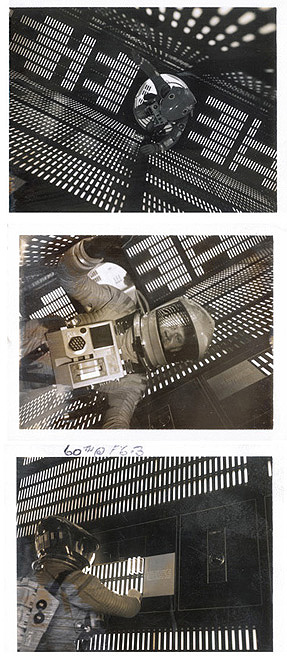[Original works from the Stanley Kubrick Estate.
Stanley Kubrick and Geoffrey Unsworth developed a system for calculating from the grey tones of b/w Polaroids the right lighting for filming
2001: A SPACE ODYSSEY.]
Update
¬ Subscribe Newsletter
Newsletter No. 6, April/May 2004
Dear colleagues and friends,
With the exhibition now open for about a month, the installations seem to have "come alive" as if Kubrick has
breathed life into them. For those entering the installation dedicated to 2001: A SPACE ODYSSEY, there is the
reconstructed interior of HAL the computer, where we can hear the sound of astronaut Bowman breathing inside
his helmet: a sound originally recorded by Kubrick himself, as Katharina Kubrick explained during her visit
of the exhibition. Other rooms also provide a lively access to the work of the film director who died in 1999.
Not only have the press and public been highly enthusiastic about the exhibition, so has Christiane Kubrick:
"The exhibition has exceeded all my expectations" she said during the opening. Since then more than 10,000
visitors have visited the exhibition located in the Deutsches Filmmuseum and the Deutsches Architektur Museum,
with some coming from so far afield as the United States and other parts of Europe. The exhibition can be seen
in Frankfurt until July 4th – we warmly invite all Newsletter readers to visit us.
1. After the opening: some press quotations about the exhibition
"This Kubrick exhibition is a cineaste event of world importance" exclaims Uwe Wittstock of
Die Welt,
while Andreas Kilb of the Frankfurter Allgemeine Zeitung writes "The exhibition is the first of its kind
and will remain the best for a long time to come. It is exemplary". The press response to the exhibition
has been enormous. Its successful opening has captured the interests of cineastes and Kubrick fans like in
both the life and work of this filmmaker: one who never quite liked being in the limelight and whose monumental
film worlds emerged largely outside the public gaze.
Andreas Kilb writes further: "When one sees them (the masks), one more beautiful than the next, and then
thinks about the central sequence surrounding the rental of costumes, one is struck in ‘Eyes Wide Shut’
by how Kubrick already conceived of it as a Kubrick exhibition, how he played retrospectively with some
of his favourite themes as if he knew that there was not much time left. Never adopting the ‘I’ as
narrator perspective, he shaped cinema according to his image and it has always been difficult not to
be amazed by him. This exhibition makes it even more difficult".
"The exhibition in Frankfurt shows the intensity in which Kubrick surrounded his material: the sharpness
of the filming that went on in his head" (Peter Kuemmel, Die Zeit). "Kubrick’s films, so different though
they are, are each a kind of prototype. They do not follow a genre, they define it. And this, as the
exhibition shows, went far beyond the films themselves" (Elke Buhr, Frankfurter Rundschau). "Above all
else...this exhibition has a goal: to promote the films of Stanley Kubrick. And dedicated to this goal
is an accompanying programme which is extensive...showing his complete works in all their original film
quality" (Gerd Klee, Wiesbadener Kurier).
2. Accompanying Film Programme
The extensive film programme accompanying the exhibition opened on March 31 with the screening of Jan
Harlan’s documentary STANLEY KUBRICK: A LIFE IN PICTURES. It afforded an opportunity to see Kubrick’s
three seldom shown short documentaries as well as his early "Film Noirs" KILLER’S KISS and THE KILLING.
During the exhibition, the cinema of the Deutsches Filmmuseum shall be screening Kubrick’s other ten
remaining feature films in original version, also A.I. – ARTIFCIAL INTELLIGENCE filmed by Steven Spielberg
based on a concept by Kubrick. Material documenting Kubrick’s works, as well as reference films and related
genre works complete the programme.
The programme will continue in May with the next six Kubrick films in chronological order: PATHS TO GLORY,
SPARTACUS, LOLITA, DR. STRANGELOVE OR: HOW I LEARNED TO STOP WORRYING AND LOVE THE BOMB, 2001: A SPACE
ODYSSEY and A CLOCKWORK ORANGE.
¬ Dates of the whole programme
3. In conclusion: the Symposium
Towards the end of the exhibition the interdisciplinary Symposium "Envisioning Kubrick" is planned to take
place in Frankfurt on the 26th and 27th of June 2004. The speakers and panelists shall examine Kubrick’s films
from different specialist perspectives, considering his works from various aspects including that of photography,
architecture, literary adaptation and art history. The French author, Michel Ciment, whose book Kubrick first
published in 1980 has become a standard work, is a special invited guest. A panel discussion with Jan Harlan,
Kubrick’s close and long time work colleague and executive producer rounds off the event.
The symposium begins in the auditorium of the Deutsches Architektur Museum on Saturday evening and continues on
Sunday in the cinema of the Deutsches Filmmuseum. There are only 130 places available. There is a charge of 29.00
Euro (19.00 Euro for students with identification). Applications, which are considered binding, must reach us by
no later than May 24.
¬ Application form can be printed out as a PDF-File.
4. Further tips and dates
The English catalogue "Stanley Kubrick" is now available. A short
¬ description and order form can be printed out
as a PDF-File.
¬ print

